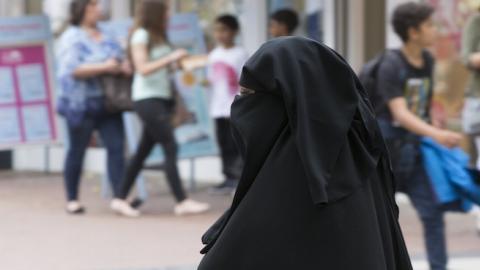In an editorial this past Thursday, the New York Times lambasted Angela Merkel’s announcement that she would move to ban the full, face-hiding Islamic veil known as the burqa or niqab, following similar moves in France, Switzerland, Belgium, and elsewhere. It is not the first time the NYT has denounced such moves. When Sarkozy moved to ban the garment in 2010, the paper titled its not-so-subtle reaction “The Taliban would applaud,” openly comparing the Taliban’s requirement that women hide their faces in public to the French Parliament’s decision that they do no such thing. On Thursday, the Times minced no word, calling Merkel’s move “bigotry” and expressing its disappointment in particular because “Chancellor Angela Merkel of Germany has been a bulwark against the anti-immigrant, anti-Muslim and anti-globalization forces afflicting Western democracies.” But there is nothing contradictory in Merkel’s move: she continues to show openness to migrants and refugees, merely asking them to embrace and live by the basic liberal principles upheld by Germany. Merkel is consistent; the New York Times isn’t—she stands against far-Right populism and against extremists forms of religious practices.
The piece then makes a curious foray into the topic of terrorism prevention, which wasn’t a reason cited by either German or French authorities when they made the case for the ban: “But that change doesn’t alter the effect of associating Muslims who maintain traditional customs with terrorism. The rapturous applause that greeted Ms. Merkel’s remarks on the ban was about Islamophobia, not a serious security concern over a rarely encountered form of dress.” This strawman bears little resemblance to the actuality of these debates, foremost concerned with practices seen by many Europeans as degrading for women. Whether or not the garments are worn “willingly” doesn’t make much difference in the underlying message they conveyed: that it is a woman’s responsibility to hide herself from public view. Man is naturally a predator, it can’t be helped, so the obligation of modesty rests solely on the woman.
The “Islamophobia” argument is absurd; in truth, the charge should be directed at opponents of the ban, not its supporters. As the NYT rightly notes, only a small minority of Muslim women wear the niqab. By claiming that the ban is an assault on Islam the editorial board thus reduces Islam to its most rigorous, extreme, and marginal interpretation. The liberal tolerance on display here plays directly into the hands of extremists who are trying to turn any questioning of their most patriarchal and reactionary worldview into “racism.” They have clearly found allies in the pages of the New York Times. And it is not the first time that the Times has leant credence to activists with such questionable motives: It has repeatedly given a platform, without any caveat, to Marwan Mohammed, the president of the Collectif Contre l’Islamophobie en France, a very controversial Islamist organization that presents itself as an anti-racist organization. The CCIF's pro-Islamist agenda has been exposed by the French left-wing press. It refused to march after the Charlie Hebdo attacks and calls closings of radical mosques acts of Islamophobia. And yet here is Mr. Mohammed quoted in the NYT, as well as here and here.
European voters are not as offensive as the Times; unlike the paper, they can tell the difference between Islam and Islamists. Indeed, according to Pew surveys, France, Germany, and the United Kingdom show the three highest levels of acceptance of Islam in Europe. Though 28 percent hold unfavorable attitudes toward Islam—which is still too high—that number is still much lower than the 61 percent recorded in the United States in 2015 by the Brookings Institution. Interestingly, those same Europeans support banning the full veil by an absolute majority: 57 percent of Brits, 81 percent of Germans, and 74 percent of the French supported the law in 2010. What gives? Is it schizophrenia? No: The European publics, who have lived with Islam among their midst longer than many American intellectuals, know how to distinguish between most Muslims and the minority of extremists who are trying to impose their ideology on the rest of their community. An irrational and obsessive fear of Islam is certainly a fixture on both side of the Atlantic, but the “Islamophobia” slur is often used as tool by extremists in this debate. Its use is much more controversial among European leftists than American, as criticism of religious practice is more common on the Continent than in the states. The former French socialist Prime Minister Manuel Valls once told Jeffrey Goldberg that he refused to employ the term because it was used to “silence critics of Islamist ideology.”
There is a legitimate debate to be had over the extent to which such measures are an infringement upon free speech. Many European countries are more comfortable banning hate speech, Holocaust revisionism, and degrading behaviors than is the United States, where the First Amendment generally prevents such prohibitions. Just this Friday, the Netherlands’ far-Right Gert Wilders was convicted of inciting discrimination. But where do we set the limits? And are these measures counterproductive? America is not immune to these questions; the censorship of foul language and nudity on television is more common here than in Europe, and pornography was subject to intense legal debates not too long ago. With the influx of Muslim immigrants, and the rising threat of Islamism, European societies are now struggling with these issues on an everyday basis. I myself have argued in these pages that the burkini bans were an counterproductive overreach (unsurprisingly overturned by the courts), though the message conveyed by the burkini was certainly an aggressive one. But the Times's editorial page doesn’t have a word to say about the worldview the burqa represents. Besides, the paper’s commitment to free speech did not extend to reproducing the Charlie Hebdo cartoons out of solidarity with the victims of the terror attacks, “because it had to consider foremost the sensibilities of Times readers, especially its Muslim readers.”
It is unfortunate because these questions deserve better debaters. In France in 2015, acts of violence and discrimination against Muslims were triple those of the previous year. Anti-Semitism has also been steadily on the rise over the past decade, often representing a majority of hate crimes in the country. European Arabs and Muslims are clearly targeted by discrimination in the workforce and hate speech. All over Europe, populist movements have used immigrants and minorities as scapegoats: in Germany, Pegida and AfD have followed that trend to great success. But European publics can still have legitimate debates over minority practices that most find intolerable in their midst. Silencing liberals and moderate conservatives who want to tackle these issues will only pave the way for more populist successes.

















